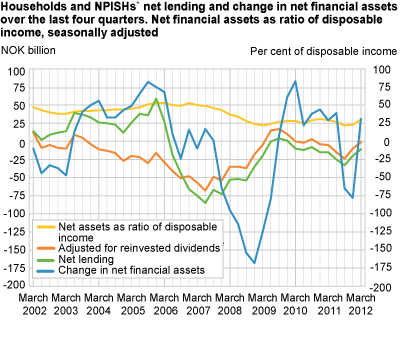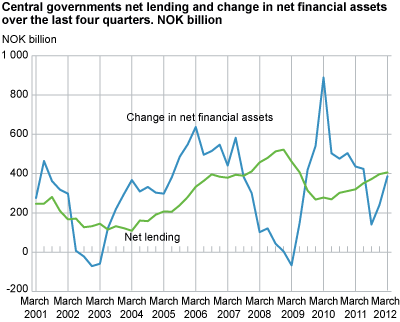Content
Published:
This is an archived release.
Households put money in banks
Households and non-profit institutions serving households increased their net lending by NOK 9 billion in the four quarter period including the first quarter of 2012. This is partly due to increased transactions in bank deposits.
Transactions in currency and deposits summarised over the last four quarters amounted to NOK 71 billion in the first quarter of 2012, up more than NOK 5 billion from 2011. This is the highest level measured in transactions in bank deposits in a four quarter period. Investment in financial assets was NOK 154 billion in the last four quarter period, which is an increase of almost NOK 9 billion from 2011. Households borrowed NOK 165 billion in the same period. This is about the same level as in the two previous four quarter periods. Despite increased financial investments net lending continues to be negative and is calculated to NOK -11 billion in the four quarter period including the first quarter of 2012.
Households data affected by a revised sector classification
A revised institutional sector classification was implemented in important source statistics for national accounts from the statistical year 2012. Households and non-profit institution serving households are two of the institutional sectors in the national accounts system which is affected by the revised sector definitions.
| 4. quarter 2009 | 1. quarter 2010 | 2. quarter 2010 | 3. quarter 2010 | 4. quarter 2010 | 1. quarter 2011 | 2. quarter 2011 | 3. quarter 2011 | 4. quarter 2011 | 1. quarter 20121 | ||||||||||||||||||||||||||||||||||||||||||||||||||||||||||||||||||||||
|---|---|---|---|---|---|---|---|---|---|---|---|---|---|---|---|---|---|---|---|---|---|---|---|---|---|---|---|---|---|---|---|---|---|---|---|---|---|---|---|---|---|---|---|---|---|---|---|---|---|---|---|---|---|---|---|---|---|---|---|---|---|---|---|---|---|---|---|---|---|---|---|---|---|---|---|---|---|---|---|
| Financial assets | 2 520 | 2 568 | 2 581 | 2 627 | 2 694 | 2 731 | 2 765 | 2 725 | 2 785 | 2 861 | |||||||||||||||||||||||||||||||||||||||||||||||||||||||||||||||||||||
| Liabilities | 2 226 | 2 238 | 2 292 | 2 307 | 2 356 | 2 373 | 2 436 | 2 469 | 2 524 | 2 540 | |||||||||||||||||||||||||||||||||||||||||||||||||||||||||||||||||||||
| Net assets | 294 | 330 | 290 | 320 | 338 | 359 | 329 | 255 | 261 | 321 | |||||||||||||||||||||||||||||||||||||||||||||||||||||||||||||||||||||
| Real figures | |||||||||||||||||||||||||||||||||||||||||||||||||||||||||||||||||||||||||||||||
| Asset to income ratio | 228.5 | 230.2 | 228.9 | 229.7 | 232.5 | 232.6 | 232.3 | 225.3 | 227.5 | 230.8 | |||||||||||||||||||||||||||||||||||||||||||||||||||||||||||||||||||||
| Debt to income ratio | 201.9 | 200.6 | 203.2 | 201.8 | 203.3 | 202.0 | 204.7 | 204.2 | 206.2 | 204.9 | |||||||||||||||||||||||||||||||||||||||||||||||||||||||||||||||||||||
| Net assets to income ratio | 26.7 | 29.6 | 25.7 | 28.0 | 29.2 | 30.6 | 27.6 | 21.1 | 21.3 | 25.9 | |||||||||||||||||||||||||||||||||||||||||||||||||||||||||||||||||||||
| Seasonally adjusted figures | |||||||||||||||||||||||||||||||||||||||||||||||||||||||||||||||||||||||||||||||
| Asset to income ratio | 229.2 | 230.1 | 227.3 | 230.8 | 233.1 | 232.5 | 230.7 | 226.3 | 228.2 | 230.8 | |||||||||||||||||||||||||||||||||||||||||||||||||||||||||||||||||||||
| Debt to income ratio | 201.2 | 201.7 | 202.4 | 202.0 | 202.6 | 203.1 | 204.0 | 204.4 | 205.5 | 206.1 | |||||||||||||||||||||||||||||||||||||||||||||||||||||||||||||||||||||
| Net assets to income ratio | 28.0 | 28.4 | 24.8 | 28.8 | 30.5 | 29.4 | 26.8 | 21.9 | 22.6 | 25.0 | |||||||||||||||||||||||||||||||||||||||||||||||||||||||||||||||||||||
| 1 | Adjusted for revised sector definition. |
In the financial accounts changes in sector definitions are classified as other changes in volume and do not affect compilation of transactions. Stocks on the other hand will be affected by changes in sector definitions, and also assets to income and liability to income ratios. Adjusted financial assets, liabilities and net assets as ratio of disposable income are provided in the table above. As shown in the table the financial assets to income ratio increased by 2.5 percentage points, while liability to income ratio and net assets to income ratio increased by 0.5 and 2.3 percentage points respectively.
Financial investments abroad increase state’s net financial assets
Central government’s net financial assets increased by NOK 386 billion from the end of the first quarter of 2011 to the end of the first quarter of 2012. The development in state’s net financial assets was highly affected by the market fluctuations in both the domestic and foreign securities markets in 2011. In particular, the drop in share prices in the second and third quarters of 2011 contributed to holding losses for central government of NOK 19 billion in the four quarter period to the first quarter of 2012. In this period, net lending was NOK 406 billion, which is NOK 9 billion higher than in 2011. Central government’s net financial assets were NOK 4 773 billion at the end of 2011. Of this, the market value of the Norwegian Government Pension Fund Global amounted to NOK 3 496 billion.
Local government’s borrowing drops
Local government’s net lending showed a significant improvement in 2011 and continued to increase in the first quarter of 2012. Net lending is estimated to NOK -17 billion in the last four quarter period, an increase by NOK 3 billion from the four quarters in 2011. The development is mainly a result of falling trend in borrowing from 2010. In the four quarter period to the first quarter of 2012 local government borrowed NOK 34 billion compared to NOK 37 billion in 2011. Total debt amounted to NOK 470 billion at the end of the last quarter, while local government’s financial assets amounted to NOK 311 billion. Negative net lending in the last years has contributed to increase net debt by NOK 60 billion from the end of the second quarter of 2010 to NOK 159 billion at the end of the first quarter of 2012.
Net foreign assets continue to increase
Norway’s net foreign assets grew by NOK 215 billion from the end of 2011 to NOK 2 835 billion at the end of the first quarter of 2012. Norway’s net lending abroad was NOK 136 billion in the first quarter of 2012, which is NOK 28 billion higher than in the previous quarter. Net holding gains, mainly due to developments in global security markets, increased the value of net financial assets abroad by NOK 78 billion in the first quarter of 2012.
| 4. quarter 2009 | 1. quarter 2010 | 2. quarter 2010 | 3. quarter 2010 | 4. quarter 2010 | 1. quarter 2011 | 2. quarter 2011 | 3. quarter 2011 | 4. quarter 2011 | 1. quarter 2012 | ||||||||||||||||||||||||||||||||||||||||||||||||||||||||||||||||||||||
|---|---|---|---|---|---|---|---|---|---|---|---|---|---|---|---|---|---|---|---|---|---|---|---|---|---|---|---|---|---|---|---|---|---|---|---|---|---|---|---|---|---|---|---|---|---|---|---|---|---|---|---|---|---|---|---|---|---|---|---|---|---|---|---|---|---|---|---|---|---|---|---|---|---|---|---|---|---|---|---|
| Financial assets | 6 000 | 6 319 | 6 683 | 6 662 | 6 877 | 7 109 | 7 013 | 7 240 | 7 191 | 7 659 | |||||||||||||||||||||||||||||||||||||||||||||||||||||||||||||||||||||
| Liabillities | 4 174 | 4 283 | 4 499 | 4 346 | 4 486 | 4 747 | 4 561 | 4 833 | 4 570 | 4 823 | |||||||||||||||||||||||||||||||||||||||||||||||||||||||||||||||||||||
| Net financial assets / net financial wealth | 1 827 | 2 035 | 2 184 | 2 317 | 2 391 | 2 362 | 2 452 | 2 407 | 2 621 | 2 835 | |||||||||||||||||||||||||||||||||||||||||||||||||||||||||||||||||||||
| Change in net financial assets / net financial wealth | -44 | 209 | 148 | 133 | 74 | -29 | 90 | -46 | 214 | 215 | |||||||||||||||||||||||||||||||||||||||||||||||||||||||||||||||||||||
| Other changes | -124 | 123 | 72 | 69 | -12 | -113 | -10 | -145 | 106 | 78 | |||||||||||||||||||||||||||||||||||||||||||||||||||||||||||||||||||||
| Net lending | 80 | 85 | 77 | 64 | 86 | 84 | 100 | 100 | 108 | 136 | |||||||||||||||||||||||||||||||||||||||||||||||||||||||||||||||||||||
DefinitionsNet lending as defined in non - financial accounts ( capital account ) = savings + net capital transfers - net acquisition of non - financial assets Net lending as defined in financial accounts = net acquisition of financial assets - net incurrence of liabilities Savings is non-consumed income and can be invested in financial or non-financial assets. If savings exceed non-financial investments, a sector has a surplus of funds and becomes a net lender to other sectors. In the financial transaction account, this means that the sector acquires more financial assets than liabilities. On the other hand, if savings are less than non-financial investments, investments have to be funded either by selling financial assets or incurring debts. Household investments in non-financial assets mainly reflect the purchase of new housing and fixed investments by unincorporated enterprises. They typically finance substantial parts of these investments by incurring debt in the form of loans. Net financial assets ( net financial wealth ) = total financial assets - total liabilities The financial balance sheet shows the financial position of a sector at the end of the reference period and is broken down into the categories of financial assets and liabilities. Insurance technical reserves, currency and deposits are the predominant assets held by households, while loans provided by financial corporations (banks etc.) constitute the main proportion of liabilities. Changes in net financial assets = net lending + other changes in assets , net The change in the financial balance sheet during the reference period is a result of accumulated financial transactions and other changes in assets. The latter category mainly reflects revaluations due to changes in market prices of financial instruments. |
Contact
-
Torbjørn Cock Rønning
E-mail: torbjorn.cock.ronning@ssb.no
tel.: (+47) 97 75 28 57
-
Jon Ivar Røstadsand
E-mail: jon-ivar.rostadsand@ssb.no
tel.: (+47) 21 09 43 69
-
Marit Eline Sand
E-mail: marit.sand@ssb.no
tel.: (+47) 40 90 26 74


